It’s probably best to keep any ESD sensitive components like semiconductors in a protective ESD bag or box.
You probably won't like mine then. I used those 60-drawer Akro units for decades. One drawer per resistor value. Even "permanent" paper labels eventually dry out and fall off. But I could have five resistors in a whole drawer. (Or 200) Took up tremendous shelf space.
I went to manila "coin envelopes" and liked it much better. Not baggies, which lose their shape. I use one envelope per value, and stand them on end, with flap facing me. I write the part information on the flap: Resistor, 1/2 watt, 100k, etc. I have the whole rest of the envelope to write on if there are notes, like a particular source, or a OEM part number, etc.
The envelopes are then stacked standing on end, and I kept them in a cardboard box, but a desk drawer would work too. In order by value, I rifle through them like I would file folders in a filing cabinet.
I used to keep my diodes in Akro drawer units, but the zeners other than 1N4744 were again, 5 or 10 in a drawer max, so tons of wasted space and a lot of shelf space taken up. SO my same coin envelopes, but on the flap I'd write Zener, 1 watt, 1N4744, etc.
I found my TO92 transistors went in envelopes well. Most types I didn't have a lot, but a few like MPSA06, 2SC1815, and some others I did have a lot, but even 100 of those small parts fit in the envelope without disrupting the rest of them.
After freeing up all those drawer units, I could then use them for TO3 transistors, bridge rectifiers, and other bulky parts that had been gathering in baggies in auxiliary storage spaces.
I find envelopes great for surface mount stuff, they never hop out of a drawer and fall into one below. Caps do tend to be bulkier, so they stayed in drawer units. I did confine my collection of small picofarad caps in discs and silver-mica to envelopes. The 60 drawer Akro units worked well enough for most of my small film caps. (0.047 or 0.022) Not so much large film caps for crossovers. But they make the same size drawer units but with larger drawers (so fewer drawers per unit) SO the 12 or 15 drawer type is good for things like 22uf/500v axials or other larger caps like 10,000uf/100v radials.
I kept a large collection of pots, since every OEM used different. The 60 drawer bins worked well for that, as well as my cement power resistors, trimmer resistors, bulk fuses.
I do have some metal shelving with open bins. Akro makes the stackable plastic bins, but I have used the cardboard bins from WW Grainger for decades, and they have held up just fine. They are the ones you buy flat in a bundle and fold up for use. I kept things like small transformers, cabinet parts like handles, bulky parts like corners. I have some of the plastic bins, but frankly I prefer the cardboard.
My favorite piece of storage gear is a 30 drawer unit that stands on teh floor, similar to the bottom half of this:
Letter Size Stackable 30-Drawer Cabinet with Literature Organizer - 33361 and more Lifetime Guarantee
Each drawer is about the size to store a ream of paper or maybe a little deeper than that. I have larger speaker parts in there like L-pads, molded EON handles. Used to have a drawer for CD laser assemblies, misc jacks take up a couple drawers, and various switches another couple. I have small plastic section boxes sorting a collection of tactile switches, two of those stack neatly in a drawer with plenty of room in front of them. One drawer is full of light bulbs, another full of batteries and battery clips/terminals/holders. One drawer is full of solder stuff. Spare small iron, spare handpiece, heater, glass tube, filters for my Pace sucker, my solder qwik stuff, tips for my Weller iron.
The nice thing about the floor unit is the top becomes a free horizontal surface, for more drawers or for whatever. A lava lamp and your autographed photo of Tim Leary.
I went to manila "coin envelopes" and liked it much better. Not baggies, which lose their shape. I use one envelope per value, and stand them on end, with flap facing me. I write the part information on the flap: Resistor, 1/2 watt, 100k, etc. I have the whole rest of the envelope to write on if there are notes, like a particular source, or a OEM part number, etc.
The envelopes are then stacked standing on end, and I kept them in a cardboard box, but a desk drawer would work too. In order by value, I rifle through them like I would file folders in a filing cabinet.
I used to keep my diodes in Akro drawer units, but the zeners other than 1N4744 were again, 5 or 10 in a drawer max, so tons of wasted space and a lot of shelf space taken up. SO my same coin envelopes, but on the flap I'd write Zener, 1 watt, 1N4744, etc.
I found my TO92 transistors went in envelopes well. Most types I didn't have a lot, but a few like MPSA06, 2SC1815, and some others I did have a lot, but even 100 of those small parts fit in the envelope without disrupting the rest of them.
After freeing up all those drawer units, I could then use them for TO3 transistors, bridge rectifiers, and other bulky parts that had been gathering in baggies in auxiliary storage spaces.
I find envelopes great for surface mount stuff, they never hop out of a drawer and fall into one below. Caps do tend to be bulkier, so they stayed in drawer units. I did confine my collection of small picofarad caps in discs and silver-mica to envelopes. The 60 drawer Akro units worked well enough for most of my small film caps. (0.047 or 0.022) Not so much large film caps for crossovers. But they make the same size drawer units but with larger drawers (so fewer drawers per unit) SO the 12 or 15 drawer type is good for things like 22uf/500v axials or other larger caps like 10,000uf/100v radials.
I kept a large collection of pots, since every OEM used different. The 60 drawer bins worked well for that, as well as my cement power resistors, trimmer resistors, bulk fuses.
I do have some metal shelving with open bins. Akro makes the stackable plastic bins, but I have used the cardboard bins from WW Grainger for decades, and they have held up just fine. They are the ones you buy flat in a bundle and fold up for use. I kept things like small transformers, cabinet parts like handles, bulky parts like corners. I have some of the plastic bins, but frankly I prefer the cardboard.
My favorite piece of storage gear is a 30 drawer unit that stands on teh floor, similar to the bottom half of this:
Letter Size Stackable 30-Drawer Cabinet with Literature Organizer - 33361 and more Lifetime Guarantee
Each drawer is about the size to store a ream of paper or maybe a little deeper than that. I have larger speaker parts in there like L-pads, molded EON handles. Used to have a drawer for CD laser assemblies, misc jacks take up a couple drawers, and various switches another couple. I have small plastic section boxes sorting a collection of tactile switches, two of those stack neatly in a drawer with plenty of room in front of them. One drawer is full of light bulbs, another full of batteries and battery clips/terminals/holders. One drawer is full of solder stuff. Spare small iron, spare handpiece, heater, glass tube, filters for my Pace sucker, my solder qwik stuff, tips for my Weller iron.
The nice thing about the floor unit is the top becomes a free horizontal surface, for more drawers or for whatever. A lava lamp and your autographed photo of Tim Leary.
I use carved wood drawers for many of my parts. The dividers are laminated wood and then engraved to value. But the trick is to only label every other bin. That way you always have a place for odd values.
For semiconductors I use notebooks with conductive foam glued to section divides. They hold thousands of parts all easy to find.
A few note books have clear vinyl pages with pockets designed to hold cards. These are found a office supply places. Makes it easy to sort and label but must be kept upright.
I use wood bins on steel shelves for bigger parts and overflow.
For semiconductors I use notebooks with conductive foam glued to section divides. They hold thousands of parts all easy to find.
A few note books have clear vinyl pages with pockets designed to hold cards. These are found a office supply places. Makes it easy to sort and label but must be kept upright.
I use wood bins on steel shelves for bigger parts and overflow.
Enzo,
Can you provide a link to your resistor envelopes?
Ed,
Would love to see photos. Sounds fancy.
Can you provide a link to your resistor envelopes?
Ed,
Would love to see photos. Sounds fancy.
I like zip baggies. I use multiple sizes, so 1 type of component in a little bag, and these are grouped into larger bags according to component type or project they were purchased for. A sharpie is used to label contents
> link to your resistor envelopes?
Enzo said "coin envelopes". However Googling "resistor envelopes" found the right things, and many-many-many other suggestions.
Amazon.com : #1 Coin and Small Parts Envelope with Gummed Flap for Home or Office Use, 28 lb. Brown Kraft, 2-1/4 x 3-1/2, 500 per Box (50162) : Office Products
Show Us Your RESISTOR collection - How do you organize them? | All About Circuits
Resistor Organizer
resistor envelopes - Google Search
Enzo said "coin envelopes". However Googling "resistor envelopes" found the right things, and many-many-many other suggestions.
Amazon.com : #1 Coin and Small Parts Envelope with Gummed Flap for Home or Office Use, 28 lb. Brown Kraft, 2-1/4 x 3-1/2, 500 per Box (50162) : Office Products
Show Us Your RESISTOR collection - How do you organize them? | All About Circuits
Resistor Organizer
resistor envelopes - Google Search
Couple of interesting ideas and links:
This adafruit stuff is stackable (snaps together) and esd safe (and cheap).
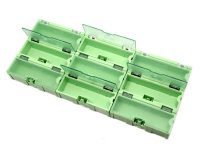
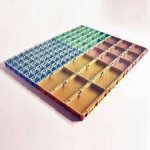
Small Modular Snap Boxes - SMD component storage - 3 pack [Green] ID: 432 - $2.95 : Adafruit Industries, Unique & fun DIY electronics and kits
Other ideas:
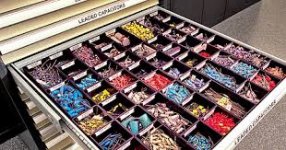
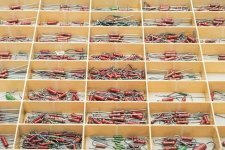
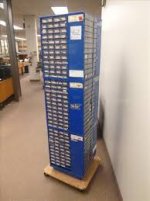
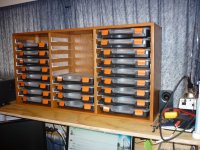
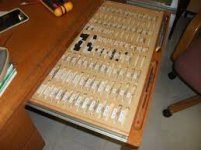
Electronics Parts Storage | Make:
Some great ideas here:
components - What's the best way to store and categorise resistors/capacitors/ICs/etc? - Electrical Engineering Stack Exchange
Enzo’s idea about minimizing unused / vacant capacity I think is critical.
Yes. Thanks.
And considering this is an issue that likely plagues is all at one time or another, it might be useful to keep a compendium somewhere as to how everyone manages their parts storage, along with helpful ideas. I’m sure also many of us have made mistakes and would do things differently if they were to “do it all over again with what I know now”.
Open source 3D printable component organizers:
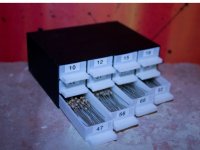
Resistor Storage (Resistor Sorter) by stylesuxx - Thingiverse
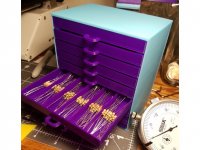
Resistor Storage Drawers by Calsgrax - Thingiverse
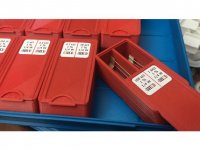
Resistor box for Small Storage System by mcmara - Thingiverse
This one is already set up and labeled for an E24 table:
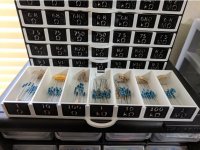
E24 Series Resistor Storage Solution by FerriteGiant - Thingiverse
Plymor 2" x 3", 2 Mil (Pack of 100) Zipper Reclosable Plastic Bags w/White Block Amazon.com: Plymor 2" x 3", 2 Mil (Pack of 100) Zipper Reclosable Plastic Bags w/White Block: Office Products
There’s got to be a better way.
This adafruit stuff is stackable (snaps together) and esd safe (and cheap).


Small Modular Snap Boxes - SMD component storage - 3 pack [Green] ID: 432 - $2.95 : Adafruit Industries, Unique & fun DIY electronics and kits
Other ideas:





Electronics Parts Storage | Make:
Some great ideas here:
components - What's the best way to store and categorise resistors/capacitors/ICs/etc? - Electrical Engineering Stack Exchange
Enzo’s idea about minimizing unused / vacant capacity I think is critical.
> link to your resistor envelopes?
Enzo said "coin envelopes". However Googling "resistor envelopes" found the right things, and many-many-many other suggestions.
Yes. Thanks.
And considering this is an issue that likely plagues is all at one time or another, it might be useful to keep a compendium somewhere as to how everyone manages their parts storage, along with helpful ideas. I’m sure also many of us have made mistakes and would do things differently if they were to “do it all over again with what I know now”.
Open source 3D printable component organizers:

Resistor Storage (Resistor Sorter) by stylesuxx - Thingiverse

Resistor Storage Drawers by Calsgrax - Thingiverse

Resistor box for Small Storage System by mcmara - Thingiverse
This one is already set up and labeled for an E24 table:

E24 Series Resistor Storage Solution by FerriteGiant - Thingiverse
I’ve been using these for some time, but as Enzo said they are floppy and not ideal... you have to “go fishing” each time you want a specific value.I like zip baggies. I use multiple sizes, so 1 type of component in a little bag, and these are grouped into larger bags according to component type or project they were purchased for. A sharpie is used to label contents
Plymor 2" x 3", 2 Mil (Pack of 100) Zipper Reclosable Plastic Bags w/White Block Amazon.com: Plymor 2" x 3", 2 Mil (Pack of 100) Zipper Reclosable Plastic Bags w/White Block: Office Products
There’s got to be a better way.
I used larger ones than PRR linked, but he did find exactly what I was talking about. I think mine were the 5-1/2" long ones. "Coin envelopes" is what they call them in the office supply store.
500 does seem like a lot, but when I sorted my resistor, my base values were 1, 1.2, 1.8, 2.2, 2.7, 3.3, 3.9, 4.7, 5.6, 6.8, 8.2, 9.1 That is 12 values per decade. Then I have those for under 1 ohm, then singles, tens, hundreds, ks, 10k., 100ks, megs. SO seven decades plug megs. Add in odd value I also have like 16k, 240k, and god knows what else. And then 1% values, my Yorkville repairs used odd things like 11 ohm resistors. There is 100 of them right there. Between 1 watt, half watt, and 5 watt, and all the voltages in the world, I had close to 50 in zeners alone.
So 500 is a healthy number, but not as large as you might think. Amazon does sell a 100 pack for ten bucks.
Amazon.com : # 5 1/2 Coin Envelope Brown Kraft 3 1/8 x 5 1/2 inches Perfect for Storing Small Parts, Coins, Jewelry, Stamps, Seeds and beeds 100 envelopes per Pack : Office Products
But for twenty some you get the 500.
I am half way through a second box myself.
500 does seem like a lot, but when I sorted my resistor, my base values were 1, 1.2, 1.8, 2.2, 2.7, 3.3, 3.9, 4.7, 5.6, 6.8, 8.2, 9.1 That is 12 values per decade. Then I have those for under 1 ohm, then singles, tens, hundreds, ks, 10k., 100ks, megs. SO seven decades plug megs. Add in odd value I also have like 16k, 240k, and god knows what else. And then 1% values, my Yorkville repairs used odd things like 11 ohm resistors. There is 100 of them right there. Between 1 watt, half watt, and 5 watt, and all the voltages in the world, I had close to 50 in zeners alone.
So 500 is a healthy number, but not as large as you might think. Amazon does sell a 100 pack for ten bucks.
Amazon.com : # 5 1/2 Coin Envelope Brown Kraft 3 1/8 x 5 1/2 inches Perfect for Storing Small Parts, Coins, Jewelry, Stamps, Seeds and beeds 100 envelopes per Pack : Office Products
But for twenty some you get the 500.
I am half way through a second box myself.
The problem I have with coin envelopes is whenever I come across an E3 or E12 or commonly used capacitor voltage/value I tend now to buy in quantity for savings.
Resistors usually a box of 50 or 100. So the coin envelope while good for oddball values doesn’t seem suited to all cases. Especially so when you get into 3 and 5 watt resistors for tube amps etc. or 450V poly caps. I’d like a solution that’s long term viable and modular for all scenarios... the oddball values, the bigger stuff and the bulk stuff.
This looks good and cheap: Anal-Retentive Resistor Organization: 4 Steps
In my searches I’ve found there’s a lot to be learned about good organization from those who are into 1. makeup and 2. beading/crafts. In most cases they put us to shame.
Bead and makeup organizers are also usually far cheaper than those designed for electronic components as well. There’s a plethora on amazon, etc. Some have used test tubes or prescription bottles which I hadn’t considered:

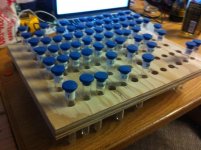
However to me something like this would be the supreme solution- can hold everything, isn’t an eyesore, etc.
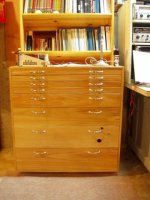
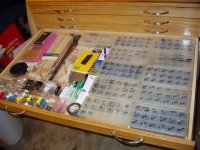
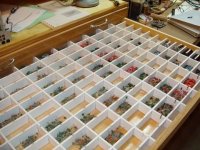
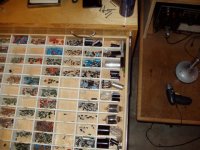
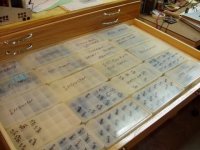
This company will make a custom lexan drawer insert so you can use a prexisting drawer that you have and get exactly the dimensions you need:
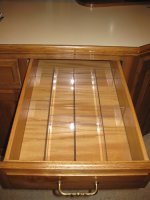
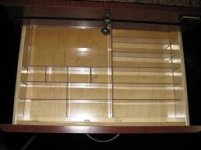
Custom Drawer Organizer and Drawer Insert
Resistors usually a box of 50 or 100. So the coin envelope while good for oddball values doesn’t seem suited to all cases. Especially so when you get into 3 and 5 watt resistors for tube amps etc. or 450V poly caps. I’d like a solution that’s long term viable and modular for all scenarios... the oddball values, the bigger stuff and the bulk stuff.
This looks good and cheap: Anal-Retentive Resistor Organization: 4 Steps
In my searches I’ve found there’s a lot to be learned about good organization from those who are into 1. makeup and 2. beading/crafts. In most cases they put us to shame.
Bead and makeup organizers are also usually far cheaper than those designed for electronic components as well. There’s a plethora on amazon, etc. Some have used test tubes or prescription bottles which I hadn’t considered:


However to me something like this would be the supreme solution- can hold everything, isn’t an eyesore, etc.





This company will make a custom lexan drawer insert so you can use a prexisting drawer that you have and get exactly the dimensions you need:


Custom Drawer Organizer and Drawer Insert
There’s tons of IKEA Alex series organizers out there.
The Alex series is basically a low cost wood(ish) version of the vidmar style cabinets by Lista etc.
They have big advocates in those sew, makeup artists, and others who need lots of tiny storage space.
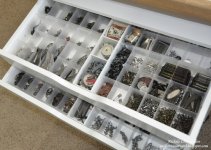 .
. 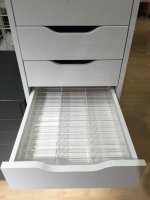
Drawer dividers for Ikea Alex << Tanya Brown's blog
You can also make your own ^
Or use something cheaper like this:
Amazon.com: Custom Drawer Organizer Tray – 20 Adjustable Metal Mesh Dividers to Create Custom Storage Sections. Easily Organize Office Desk Supplies and Accessories. Perfect Home or Office Drawer Tray. (Black): Office Products
I think these are the winner for cost, nice design, most storage efficiency due to the Alex series wide, short drawers. The drawers themselves are around 150 (tall one) or around 120 (wide one), plus cost of your choice of inserts.
After a lot of searching this appears to be the best option unless you want to spend lots of money on a commercial or purpose built solution. Or go with Akro Mills, but this isn’t an aesthetically pleasing solution for me.
The Alex series is basically a low cost wood(ish) version of the vidmar style cabinets by Lista etc.
They have big advocates in those sew, makeup artists, and others who need lots of tiny storage space.
 .
. 
Drawer dividers for Ikea Alex << Tanya Brown's blog
You can also make your own ^
Or use something cheaper like this:
Amazon.com: Custom Drawer Organizer Tray – 20 Adjustable Metal Mesh Dividers to Create Custom Storage Sections. Easily Organize Office Desk Supplies and Accessories. Perfect Home or Office Drawer Tray. (Black): Office Products
I think these are the winner for cost, nice design, most storage efficiency due to the Alex series wide, short drawers. The drawers themselves are around 150 (tall one) or around 120 (wide one), plus cost of your choice of inserts.
After a lot of searching this appears to be the best option unless you want to spend lots of money on a commercial or purpose built solution. Or go with Akro Mills, but this isn’t an aesthetically pleasing solution for me.
DIY / Ikea Parts Storage Hacks
I’ve also done the labeled plastic bag thing, the stacked drawer thing (small parts don’t weigh much, those things shift around and never work out the way one envisions) and all kinds of other solutions that have gradually turned into a bunch of different failed ideas on a shelf that I shiver when looking at, wondering what box or bag or whatever do I start looking in to find the 787K Holco resistors I bought by accident 3 years ago.
IMHO the way to go if you want lots of part storage and don’t want an eyesore or a mess, drawers and inserts is the only viable way forward.
I’ve done the clear tub thing and it just gets unwieldy and messy after a while. Also doesn’t cover strange cases well like that odd 0.1% resistor you only have three of, etc.Those are some great ideas folks.
I'm the kind of person that needs to see what is in there, so I use the plastic tubs and I have parts in clear plastic bags with parts written on them, such at 470uf 100V, etc.
I've seen suggest that folks use school type three ring binders with business card type inserts with SMD parts in them.
I’ve also done the labeled plastic bag thing, the stacked drawer thing (small parts don’t weigh much, those things shift around and never work out the way one envisions) and all kinds of other solutions that have gradually turned into a bunch of different failed ideas on a shelf that I shiver when looking at, wondering what box or bag or whatever do I start looking in to find the 787K Holco resistors I bought by accident 3 years ago.
IMHO the way to go if you want lots of part storage and don’t want an eyesore or a mess, drawers and inserts is the only viable way forward.
Last edited:
Here’s multiple configurations using the Alex series:
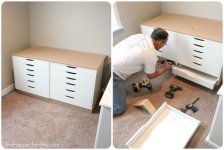 .
.  .
. 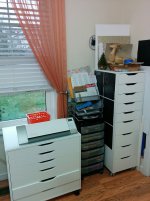 .
. 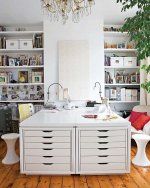 .
.
 .
.  .
. 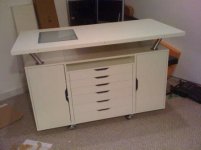 .
. 
A poor mans (maybe 30x less expensive at least?) / home friendly Lista, Stanley or other Vidmar style drawer system:
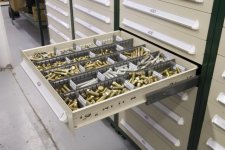 .
. 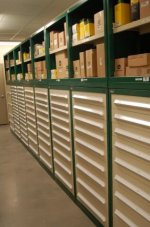
http://www.stanleyvidmar.com/sites/www.stanleyvidmar.com/files/pdfs/VidmarCatalog_2015.pdf
SCP3163AL 59"H Pre-configured Cabinet with 8 Drawers Dark Blue | Vidmar | QuickShip
 .
.  .
.  .
.  .
.  .
.  .
.  .
. 
A poor mans (maybe 30x less expensive at least?) / home friendly Lista, Stanley or other Vidmar style drawer system:
 .
. 
http://www.stanleyvidmar.com/sites/www.stanleyvidmar.com/files/pdfs/VidmarCatalog_2015.pdf
SCP3163AL 59"H Pre-configured Cabinet with 8 Drawers Dark Blue | Vidmar | QuickShip
Last edited:
Well it all depends on whether you want a professional shop parts inventory or you are building a home hobby parts kit. My commercial shop held a ton of parts. SO I had a large parts storage. But a guy building one-off amps in his basement would need nothing like my collection.
I specifically excluded larger parts from my envelopes. I consider shelf space valuable and limited, so I see the envelopes as a way to compact tiny parts like resistors and diodes into a small space, leaving the drawer units for larger parts like 5 watt resistors or pots. I used the large drawer Akros for things like large electrolytics.
I specifically excluded larger parts from my envelopes. I consider shelf space valuable and limited, so I see the envelopes as a way to compact tiny parts like resistors and diodes into a small space, leaving the drawer units for larger parts like 5 watt resistors or pots. I used the large drawer Akros for things like large electrolytics.
Yes Enzo, I am not opposed in the least to the coin envelopes.
But my goals are:
1. a solution that can store all of the following:
Electrolytics high and low voltage
film caps
Transistors
Tubes
Tube sockets
Heatsinks
Solder and soldering accessories
Resistors high and low wattage
Chassis hardware, nuts, bolts, fuses, etc.
Rectifiers
2. Be easily retrievable from a seated position
3. Store everything completely out of sight if desired. Basically, to not resort to the common clear plastic storage drawers you mentioned. I don’t find this appealing to have in the home, even if it’s in a hobby area. I’ve caved before and got them in the interim, but I’d like something better.
4. Be visually appealing / look like furniture. Also will increase WAF / acceptance of hobby in the home / reduce clutter, which is a big plus for many id imagine.
So while coin envelopes are a great idea (I may get some and line the box with contains them with esd safe liner) it is only a piece of the puzzle for me.
I need something that serves all of my needs.
I don’t think I’m alone in this and I think many here have likely spent a great deal of time considering and money pursuing solutions to this issue.
Thus I think it’s wise to put our heads together.
Given that ikea is:
1. present all over the world
2. Inexpensive
3. many of their solutions are modular and expandable
4. Many have aftermarket products and hacks
I think it’s a perfect place to look.
I don’t want a giant Vidmar storage solution. I want something small like the ikea; that I can expand as needed, that can be on rollers or used as a small side table.
But my goals are:
1. a solution that can store all of the following:
Electrolytics high and low voltage
film caps
Transistors
Tubes
Tube sockets
Heatsinks
Solder and soldering accessories
Resistors high and low wattage
Chassis hardware, nuts, bolts, fuses, etc.
Rectifiers
2. Be easily retrievable from a seated position
3. Store everything completely out of sight if desired. Basically, to not resort to the common clear plastic storage drawers you mentioned. I don’t find this appealing to have in the home, even if it’s in a hobby area. I’ve caved before and got them in the interim, but I’d like something better.
4. Be visually appealing / look like furniture. Also will increase WAF / acceptance of hobby in the home / reduce clutter, which is a big plus for many id imagine.
So while coin envelopes are a great idea (I may get some and line the box with contains them with esd safe liner) it is only a piece of the puzzle for me.
I need something that serves all of my needs.
I don’t think I’m alone in this and I think many here have likely spent a great deal of time considering and money pursuing solutions to this issue.
Thus I think it’s wise to put our heads together.
Given that ikea is:
1. present all over the world
2. Inexpensive
3. many of their solutions are modular and expandable
4. Many have aftermarket products and hacks
I think it’s a perfect place to look.
I don’t want a giant Vidmar storage solution. I want something small like the ikea; that I can expand as needed, that can be on rollers or used as a small side table.
Well if you want it to look like a finished home, maybe a folding door to cover teh wall area taken up by storage. Or even false front book cases that openlike doors to reveal storage behind. I don;t mean that flippantly, It could seriously work.
I am not married to my envelopes, just want to be clear my intentions for them. They would fit in a drawer of an Ikea solution.
The problem I see is that one solution has to cover tiny things like a dozen 16v zeners, and a power transformer. 25 different Fender guitar amp pots, and a selection of 10 watt resistors. That is like several orders of magnitude, size-wise.
Some things like screws are just begging for multi-cell plastic storage boxes.
When I buy bulk fuses by the hundred, they get poured in a drawer. When I order a box of five or two boxes, those either go in a drawer or into my wall rack of fuse box holders. (Point of sale items from Littelfuse) Lose fuses I buy in small amounts went in to a plastic multicell box. These boxes are sold as fishing lure boxes or as crochet thread spool boxes. They stack on a shelf easily.
Every person with a shop has to deal with parts storage. Rarely does one get to plan out a parts storage system from scratch, usually the system grows over time. I started saving parts 60 years ago. MY one drawer unit turned into a wall full of them. Cardboard boxes on the floor under the bench became part bins on metal shelves. A box of schematics turned into a wall of shelves full of three-ring binders, and those supplemented my file cabinets full of service manuals.
I am not married to my envelopes, just want to be clear my intentions for them. They would fit in a drawer of an Ikea solution.
The problem I see is that one solution has to cover tiny things like a dozen 16v zeners, and a power transformer. 25 different Fender guitar amp pots, and a selection of 10 watt resistors. That is like several orders of magnitude, size-wise.
Some things like screws are just begging for multi-cell plastic storage boxes.
When I buy bulk fuses by the hundred, they get poured in a drawer. When I order a box of five or two boxes, those either go in a drawer or into my wall rack of fuse box holders. (Point of sale items from Littelfuse) Lose fuses I buy in small amounts went in to a plastic multicell box. These boxes are sold as fishing lure boxes or as crochet thread spool boxes. They stack on a shelf easily.
Every person with a shop has to deal with parts storage. Rarely does one get to plan out a parts storage system from scratch, usually the system grows over time. I started saving parts 60 years ago. MY one drawer unit turned into a wall full of them. Cardboard boxes on the floor under the bench became part bins on metal shelves. A box of schematics turned into a wall of shelves full of three-ring binders, and those supplemented my file cabinets full of service manuals.
For me and my very small collection of parts (compared to what I am seeing here) what has been more important than the actual physical storage is to maintain a (fairly accurate) spreadsheet inventory of what I have. It took some time putting it together and you need to be diligent in entering details of new parts, but I can see pretty quickly if I should have any component of a particular value before I even start looking (the parts themselves are usually still in the small plastic envelopes they came in, stacked in plastic boxes grouped by part type.
The problem I see is that one solution has to cover tiny things like a dozen 16v zeners, and a power transformer. 25 different Fender guitar amp pots, and a selection of 10 watt resistors. That is like several orders of magnitude, size-wise.
Indeed!
What I like, but still not perfect, are the boxes with inserts from e.g. Allit24. An example is here:
Allit 457202 Sortimentskasten"Euro-Plus": Amazon.de: Baumarkt
One can get the inserts only, and stick them in a alex drawer.
Two nice things:
- different sizes,
- very important: they can be taken out separately, so just start organizing and shuffle them around until the layout in the drawer is nice. The sorting boxes with fixed divisions are a pain to reorganize...
Still, even the smallest size I could find are like 40x40mm, which is to big for 10 small resistors. And filling some alex drawers will them will eventually cost quite some money.
Another note: I could not find the coin envelopes mentioned by Enzo and would prefer transparent ones to see what is in there (specially the quantity of resistors remaining) - but indeed, zip lock backs dont stand up well. What I did was inserting a piece of "thick paper" (about 250gr/m2) in a zip lock bag: transparent, stands up, and I can write on the paper.
So the resistors came out of their sorting boxes, comparable to the allits I posted above, which are now being used for screws, nuts and washers (which are too heavy for zip lock bags).
So the resistors came out of their sorting boxes, comparable to the allits I posted above, which are now being used for screws, nuts and washers (which are too heavy for zip lock bags).
Erik, I like that idea as well.
Anyone know where the below can be sourced?
I have a bunch of these I got from a source of old stock, but no blank labels.
A good way to keep bags standing upright.
Plus can be used for larger quantities, easy to write on and even has room to cut and tape the distributor label.
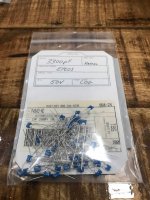
Anyone know where the below can be sourced?
I have a bunch of these I got from a source of old stock, but no blank labels.
A good way to keep bags standing upright.
Plus can be used for larger quantities, easy to write on and even has room to cut and tape the distributor label.

Last edited:
- Home
- Design & Build
- Parts
- Parts Storage, Organization and Labeling